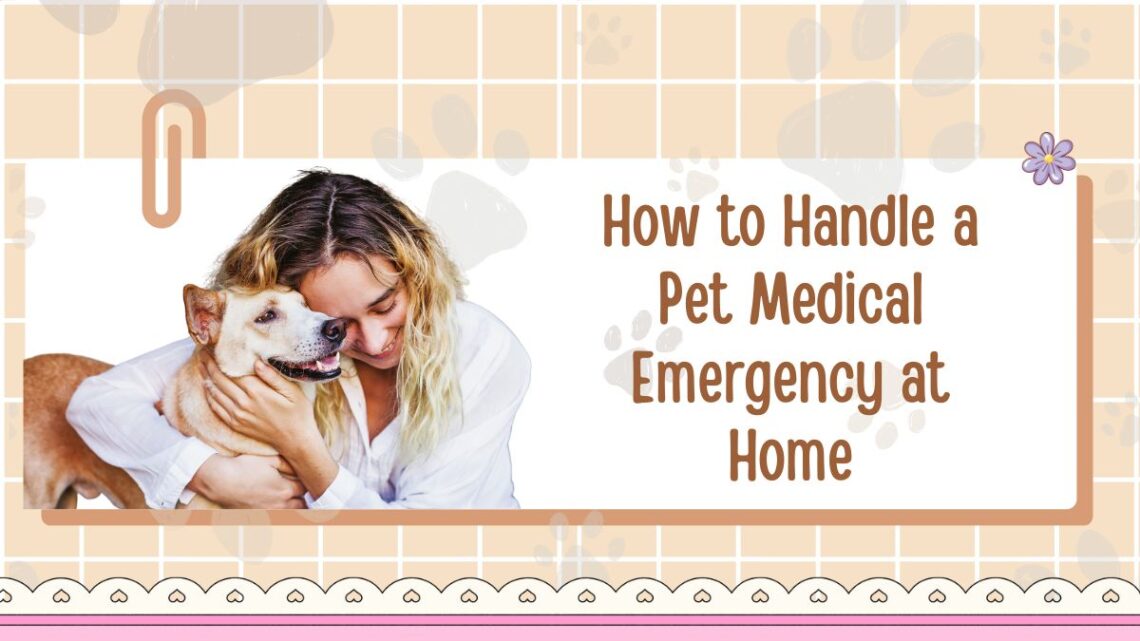A medical emergency involving your beloved pet can be one of the most frightening moments a pet owner faces. Whether it’s your dog suddenly collapsing, your cat unable to urinate, or an accidental ingestion of something toxic, knowing what to do in those first crucial minutes can make all the difference.
This guide covers step-by-step actions, common emergencies, how to build a home emergency kit, prevention strategies, and what to do while you get professional help. With accurate, up-to-date figures and a clear-cut table summarising key information, you’ll be better prepared for when things don’t go as planned
Recognising a Pet Medical Emergency
Identifying the signs early is critical. According to veterinary sources, many pets are brought to emergency care for: severe vomiting/diarrhoea, uncontrolled bleeding, difficulty breathing, foreign object ingestion, and heatstroke.
Here are key symptoms to watch for:
- Difficulty breathing, panting excessively or gasping
- Uncontrolled bleeding or deep wounds
- Sudden collapse or loss of consciousness
- Seizures or trembling
- Marked abdominal swelling or “distended” stomach (especially in dogs)
- Inability to urinate (especially in male cats)
- Heat stroke signs: red or blue gums, rapid breathing, disorientation
- Suspected poisoning or ingestion of toxic items—e.g., human painkillers, grapes, raisins, antifreeze.
If you notice any of these, treat it as an emergency. Time matters.
Common Types of Pet Emergencies & Their Causes
Here is a breakdown of the most frequent emergencies, what triggers them, and why they’re so urgent:
| Type of Emergency | Typical Causes | Why It’s Serious |
|---|---|---|
| Gastric Dilatation & Volvulus (GDV or “bloat” in dogs) | Large-breed, deep-chested dogs, eating large meals, exercising right after eating | The stomach twists, cutting off blood supply; can be fatal if not treated quickly. |
| Trauma / Injury | Hit by car, falls, animal attack, household accidents | Bleeding may be internal; bone fractures; hidden injuries. |
| Heatstroke / Hyperthermia | Exposure to high heat, leaving pets in cars, brachycephalic breeds, lack of water | Overheating damages organs rapidly. |
| Foreign body obstruction | Swallowing toys, socks, bones, wrappers | Can block intestines or stomach—requires surgery. |
| Poisoning / Toxic ingestion | Human medications (ibuprofen, Tylenol), food toxins (chocolate, grapes), antifreeze, household chemicals | Toxins may cause organ failure, neurological collapse. |
| Urinary blockage / infection (common in cats) | Male cats with narrow urethras, stones, infections | Urine can’t exit the body → deadly if untreated. |
| Dehydration / Heat Exhaustion | Vomiting, diarrhoea, heat exposure, limited water | Causes organ failure, collapse. |
| Respiratory infections / Pneumonia | Virus, bacteria, aspiration | Pet can’t breathe properly → urgent. |
| Allergic reactions | Insect sting, new food, medication | Can escalate to anaphylaxis quickly. |
Immediate Actions to Take at Home (First Aid)
When faced with a pet emergency at home, your goal is to stabilise the pet and get professional help as soon as possible. Here are clear steps to follow:
Stay Calm & Assess
- Take a deep breath: pets pick up on panic, and you need a clear head.
- Safely approach your pet: injured animals may bite or scratch; for a cat, you may need to wrap a towel loosely to protect yourself.
- Check for signs of life: breathing, pulse (feel inside thigh in dogs), pupils.
Call the Vet/Emergency Clinic
- Before attempting complex procedures, call your regular vet or any 24-hour emergency veterinary clinic.
- Provide: what happened, your pet’s species/breed/age/weight, symptoms, what you’ve done so far.
- Ask: “Is this an emergency? Should I bring them now?”
Basic First Aid Measures
Here are home interventions while transporting your pet:
- Bleeding: apply clean gauze with gentle pressure; elevate limb if possible.
- Choking/airway obstruction: open the mouth, if visible object, try to remove with tweezers; if not visible, perform a modified Heimlich (for dogs).
- Heatstroke: move to shade, cool down with lukewarm water (not ice-cold), offer small sips of water, transport quickly.
- Poisoning suspicion: don’t induce vomiting unless directed by vet; bring packaging of substance.
- Difficulty breathing: minimise stress, open airway, keep upright, transport immediately.
- Seizure: keep pet safe, do not put hand in mouth, cushion their head, note time of seizure and duration.
Transporting Your Pet to Emergency Care
- Use a pet carrier, box, or sturdy board for dogs if spinal injury is suspected.
- Keep your pet warm but not overheated during transport.
- Ensure you have blanket/towel to wrap pet.
- On arrival, hand over any info: what happened, time, first aid given.
Building a Home Pet Emergency Kit
Being prepared is half the battle. Having an accessible kit means you can act faster. Include:
- Gauze pads, non-stick bandages, adhesive (vet wrap)
- Digital thermometer (normal: dog ~101-102.5°F / cat ~100.5-102.5°F)
- Saline solution (to flush wounds)
- Tweezers, blunt scissors
- Muzzle (for dogs) or towel (for cats)
- Flashlight
- Disposable gloves
- Blanket/towel
- Emergency contact list: your vet, nearest 24-hour clinic, poison control number
- Medical records: vaccination status, chronic conditions, medications
- Pet carrier or suitable transport box
- Water and pet food
- Copy of your pet’s microchip info or ID tag.
Prevention & Preparation to Minimise Risk
Prevention is always better than reaction. These steps reduce the likelihood of emergencies:
- Regular veterinary check-ups: detect issues before they become emergencies.
- Maintain proper diet and exercise: avoid obesity, which increases risks like GDV.
- Pet-proof your home: store medications, cleaners, toxic plants, small objects out of reach.
- Supervise pets outdoors: watch for cars, wildlife, chemicals.
- Know your pet’s breed risks: e.g., deep-chested dogs, brachycephalic dogs (flat faces) more prone to heatstroke.
- During extreme weather: in hot climate avoid midday walks, never leave pet in car; in winter, prevent hypothermia/frostbite.
- Microchip your pet and keep ID tags updated: makes recovery easier if they bolt during an emergency.
- Train yourself in basic pet CPR/first aid (there are courses online) so you’re ready when it counts.
What Happens at the Vet / Emergency Clinic?
When you arrive at the clinic, the veterinary team will perform triage, diagnostics, and treatment. Key steps typically include:
- Taking a full history: what happened, when, what you observed.
- Physical exam and vital signs (pulse, respiration, mucous membrane colour)
- Diagnostic tests: blood work, imaging (x-ray/ultrasound) to detect internal problems.
- Treatment: may include IV fluids, oxygen therapy, surgery, antidotes (for poisoning), bandages, medications.
- Monitoring: some pets stay in hospital for hours or days depending on severity.
- Owner communication: you’ll be informed of prognosis, cost, and next steps.
Cost & Financial Preparedness
Pet emergencies can be costly. For example:
- A survey found that in 2024 the average cost of an unexpected pet health event in the U.S. was US $560.80.
- Only roughly 52% of pet owners said they were ready for such expenses in 2024 — down from 82% in 2023.
- Toxic ingestion cases: the U.S. pet poison control centre received over 401,550 calls in 2021.
Given this, it’s wise to:
- Set aside an emergency pet fund.
- Consider pet insurance which covers emergencies.
- Know your clinic’s payment options — some offer payment plans.
- Keep track of your pet’s insurance, records, and emergency contact list in an easily accessible place.
Emotional & Practical Considerations During a Crisis
- Stay as calm as possible — your pet senses stress.
- Keep children or other pets away from the injured animal to avoid further distress.
- Enlist help: a partner or friend can help carry the pet, make calls, drive.
- After emergency care, monitor your pet at home, follow-up with your regular vet, and update any preventive plan.
- Reflect and prepare: once the crisis passes, rebuild or restock your emergency kit; review what you learned to improve readiness for next time.
A pet medical emergency can strike without warning. The moment your pet shows signs like collapse, breathing difficulty, severe bleeding, or ingestion of something toxic, you must act—fast and calmly. Recognising the danger, performing immediate basic first aid, transporting your pet safely, and getting them to emergency care can save their life.
Equally important is being prepared: having an emergency kit ready, pet-proofing your home, and budgeting for potential costs.
By following the steps in this guide, you’re not only reacting to crises—you’re proactively protecting your pet’s health and ensuring you’re equipped for the unexpected. Stay prepared, stay calm, and give your pet the best chance of recovery should the worst happen.
FAQs
If your pet has symptoms such as difficulty breathing, uncontrolled bleeding, collapse/unconsciousness, persistent vomiting/diarrhoea (especially with blood), or you suspect poisoning or foreign body ingestion—go immediately to an emergency vet rather than waiting.
Yes, you can in certain situations. If your pet is unconscious and not breathing, you can place them on their side, extend head/neck, hold jaws closed and breathe into their nostrils once every 3 seconds in dogs (cats similarly), until veterinary help is available. Always call your vet for instructions first.
Start by having a dedicated emergency fund for your pet. Explore pet health insurance that covers emergencies. Keep your pet’s health records updated and vet clinic credentials ready. Know payment plan options and identify the nearest 24-hour emergency vet ahead of time.





